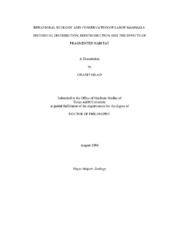| dc.description.abstract | Conservation biologists have used reintroduction as a method to reestablish extirpated species in their native habitat. Three important aspects of a successful reintroduction effort include: (1) a habitat suitability study of the reintroduction area, including effects of migration corridors; (2) identification of possible predators of the reintroduced species; and (3) a post-reintroduction assessment including an evaluation of the species' population dynamics. In this study I examine the suitability of Guadalupe Mountains National Park (GUMO) as a reintroduction area for desert bighorn sheep. The study used landscape metrics to compare GUMO to a nearby mountain range that is currently supporting an estimated population of 400 bighorn sheep. This study identified migration corridors for bighorns throughout the region and evaluated mountain lion (a potential predator of bighorn sheep) numbers either residing in or passing through the park between the years 1997 to 2004. Results on the studies in GUMO revealed 15,884 ha of suitable habitat for bighorn sheep and provided evidence of migration routes between GUMO and neighboring mountain ranges. In terms of potential predators, a minimum of 32 resident and/or transient mountain lions occurred in GUMO over a seven year period, and a minimum of 15 cats used the park in 2002. Based on estimates of individual home range of males and females, GUMO should be able to support four to five individuals. The genetic data indicates a high number of transients or perhaps an unstable population of mountain lions that may be the result of intense hunting pressure of cats in Texas. Finally, my study simulates parameters of the population dynamics of a different species, the Arabian oryx that was reintroduced as three separate populations to the Israeli Negev between 1998 and 2005. I simulated population growth and the effect of migration corridors on species persistence. Results suggest that migration corridors are essential for a self-sustaining viable metapopulation under current natality rates. In the event that natality rates increase (as was evident in a reintroduced population of Arabian oryx in Oman), metapopulation can reach viable size with only two of the release sites (open, flat terrain) connected by migration corridors. | en |


